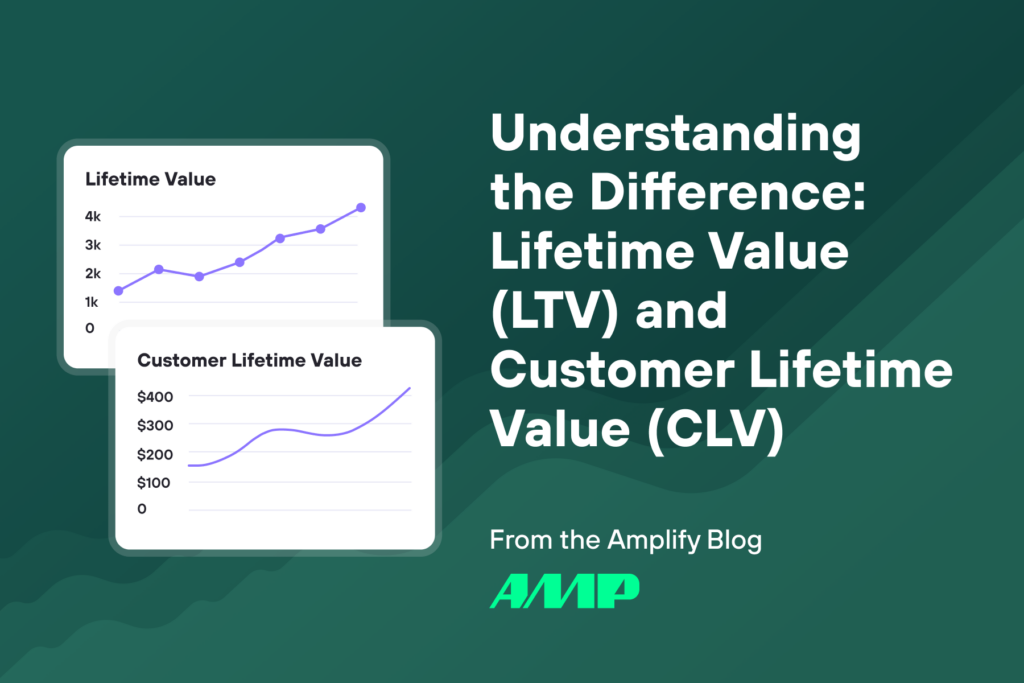May 2, 2024
Understanding the Difference: Lifetime Value (LTV) and Customer Lifetime Value (CLV).
Two very confusing abbreviations seem to get lost in translation because they seem so similar – Lifetime Value (LTV) and Customer Lifetime Value (CLV). LTV and CLV are two different ways to understand the financial health of your customers and your online store. Understanding how to use these two metrics will help you make strategic decisions and understand your profitability. Let’s check out what makes these concepts impactful and how to use them for your business.

What is Lifetime Value (LTV)?
Lifetime value (LTV) is the total of how much revenue you expect to earn from the average customer throughout their entire relationship with your company. Like a financial crystal ball, predicting how profitable your customer base will likely be over time.
What is Customer Lifetime Value (CLV)?
Customer lifetime value (CLV) gets more personal. This is similar to putting a magnifying glass on each customer to calculate how much money they are likely to spend with your business over their lifespan as a buyer. CLV allows you to tailor marketing strategies and nurture specific customer relationships for maximized returns.
The Importance of LTV and CLV
While these financial projections sound interesting, why do they matter? Here’s why:
- Smart Spending: Let’s say it costs you $50 to acquire a customer. If their LTV or CLV is only $30, there might be trouble ahead. Knowing these values helps you spend wisely on marketing and makes sure you are receiving a good return on your investment.
- Laser-Focused Customer Strategies: CLV helps you understand which customers are your VIPs – the ones who consistently return and spend big. You can focus on acquiring more lookalike customers or tailor special rewards programs to keep them loyal.
- Better Business Decisions: LTV and CLV inform everything from product development to pricing. If you know your average customer remains loyal for five years, you can make design choices that encourage long-term engagement and upsell opportunities.
How to Leverage LTV and CLV
Firstly, there is a way to calculate LTV and CLV. The basic LTV formula is Average Purchase Value x Number of Repeat Purchases x Average Customer Lifespan. To calculate CLV you’ll need individual customer transaction data along with churn rate information. There are several simplified and more complex models for both metrics.
Secondly, you need to segment your customer base by segmenting customers by demographics, purchase behavior and other relevant factors. Then, calculate CLV for each segment so you can pinpoint your most valuable customer profiles.
Thirdly, high-CLV customers deserve tailored marketing that reflects their value by offering a rewards system, exclusive promotions, or personalized recommendations to strengthen their loyalty and increase spending.
Finally, the use of LTV to determine sustainable budgets for acquiring new customers and learning retention tactics from knowing the CLV. These help your ongoing search for new or retained customers.
There is another way to calculate and leverage these two metrics, and it’s using an app: Lifetimely LTV & Profit by AMP. This app can track profit, calculate precise LTV, marketing analytics, customer pattern behaviors and measure your CLV. Lifetimely integrates directly, combing through data providing comprehensive metrics, easily applied and sorted through this one app.
LTV and CLV in Action
Understanding LTV and CLV is great, but the real magic happens when you use these metrics to fuel your business growth. Here’s how to make them work for you:
- Smarter Customer Acquisition: If your average LTV is high, it might make sense to spend more money acquiring new customers. Focus on attracting customers who share traits with your existing high-CLV clientele – this means finding more people likely to become loyal, long-term spenders.
- Retention is Gold: Nurturing existing customers is 5 times cheaper than getting new ones. CLV spotlights your most valuable customers. Roll out the red carpet with loyalty programs, exclusive deals, and personalized experiences. Make them feel like they’re your favorite!
- Upselling & Cross-Selling Opportunities: Customers with high CLV are more receptive to additional offers. Analyze their purchase history and recommend products or services that complement what they already enjoy. Think of it as helping them find the perfect additions to their experience. To create a successful upselling experience, look for Upsell by AMP. Boost your average order value in minutes when you add upselling to pre-purchase, post-purchase and thank you pages with Upsell by AMP.
- Pricing Power: Let LTV and CLV guide your pricing decisions. You might be surprised to find that your most loyal customers are willing to pay a little more. Additionally, if a customer segment has a consistently low CLV, you may need to rethink your pricing or offerings for that group.
Forget treating all customers the same! LTV and CLV shed light on the hidden value within your customer base. By understanding and leveraging these metrics, you can make smarter decisions that directly fuel growth and success for your business.
Track your Repurchase Rate and other Customer Behaviour metrics with one tool.
Start today,
for free
Start a free trial of any of AMP’s tools today.

